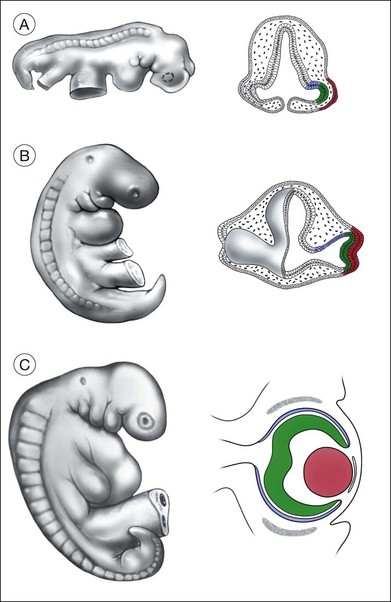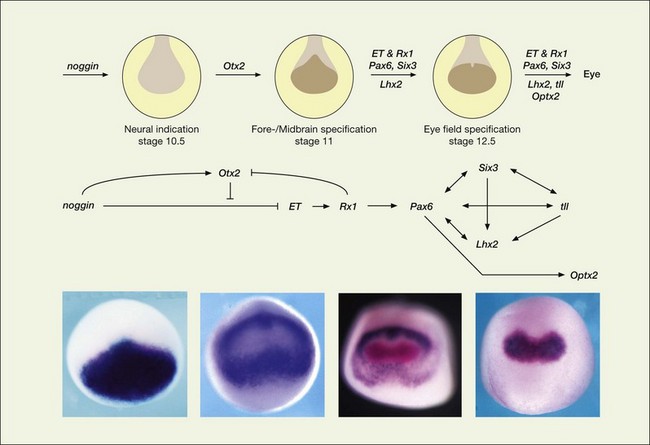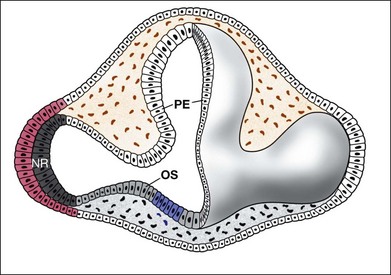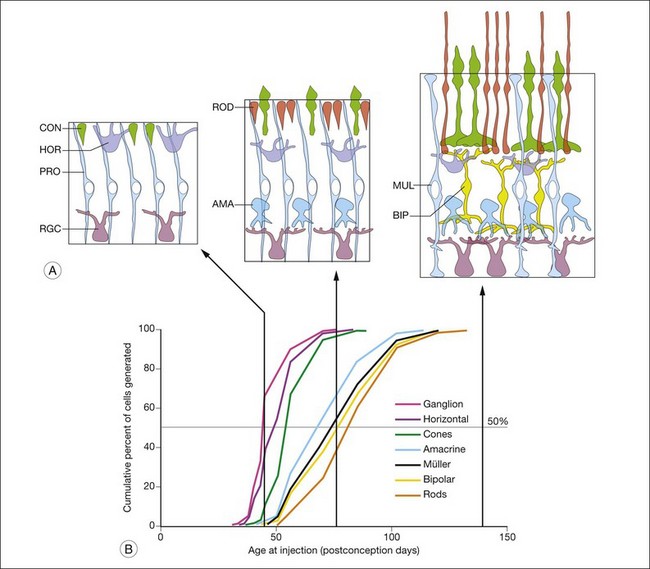Chapter 13 The Development of the Retina
Embryology of the eye
The retina is first recognized as the optic pit in the anterior neuroectoderm at day 23 of gestation1; a few days later (day 25) the optic vesicle can be recognized as an evagination from the diencephalon of the neural tube (Fig. 13.1). The optic vesicles initially lie immediately adjacent to the ectoderm (Fig. 13.1), but then a layer of mesenchymal cells, derived from the neural crest, becomes interposed between the ectoderm and the vesicles. The neural crest cells that surround the developing optic cup, along with the periocular mesenchyme, contribute to many ocular tissues: the corneal endothelium, the choroid, the ciliary body and the retinal vasculature (including the hyaloid artery).2 During the next stage of ocular development, the optic vesicle folds in on itself, becoming the optic cup, and the lens ectoderm invaginates into the vesicle (Fig. 13.1). The resulting two tissue layers of the optic cup are the outer presumptive retinal pigment epithelium (RPE) and the inner presumptive neural retina, with the lens vesicle filling much of the interior of the cup. In humans, these dramatic morphologic changes occur at approximately 25–35 days of gestation. The optic stalk, connecting the developing retina with the diencephalon, will form the scaffold for the growing axons of the optic nerve. The developing optic cup grows around the stalk from the dorsal sides, fusing to form the ventral (or embryonic) fissure. This fissure “closes” at day 33 in the human embryo, and incomplete closure of the fissure occurs from mutations in several different genes leading to colobomas (Table 13.1). The hyaloid artery, the major source of blood for the embryonic retina and lens, enters the eye through the ventral fissure. The hyaloid artery regresses by birth, but the central retinal artery remains. Incomplete or delayed regression of the hyaloid artery can lead to vitreal hemorrhage and studies in mice have implicated the gene Norrin in this process.3
The eye field
Although the eye is first apparent as it evaginates from the diencephalon, this region of the embryo is already specified to give rise to the eye some time earlier.4 Since much of the experimental embryology of the developing eye has been carried out in frog and chick embryos, most of the information on this process is derived from these species; however, it is likely that the process of eye development has been largely conserved throughout vertebrate evolution, and most of what has been learned from other species is likely to be true of human eye development as well. During gastrulation, the process known as neural induction transforms a region of ectoderm into the precursors of the central nervous system (CNS), called the neural plate. Even at these early times in development, the anterior region of the neural plate is specified to give rise to the retina. This region is called the eye field. Indelibly labeling the cells in the eye field of the neural plate with vital dyes allowed embryologists of the 1920s to track the cells as they developed into the neural retina and pigmented epithelium (Fig. 13.2). Additional evidence that the eye field cells were specified to produce eye tissue came from transplantation studies of these cells to ectopic locations, such as the trunk or tail of other embryos; ectopic eyes formed from the transplanted cells. In situ hybridization studies to localize these genes have shown that genes that are critical to eye development are expressed in the eye-forming regions of the neural plate before any clear morphologic differentiation into retinal structures (see below).
What makes the eye field cells capable of generating retina? In part, the eye-forming character of these cells comes from their expression of a group of proteins, called the eye field transcription factors (EFTFs), which bind to DNA and selectively activate genes important for eye development.5 Among the first of these transcription factor genes to be expressed in eye development is Pax6. Pax6 codes for a transcription factor that is a member of the paired class of homeodomain proteins. Transcription factors of this class are expressed very early in the development of many tissues and appear to be involved in controlling the identity of the various regions of the embryo. Pax6 is expressed in the eye field, and continues to be expressed by both the optic vesicle and the developing lens. Mutations in this gene cause a phenotype in mice characterized by small eyes and aniridia in humans.6 The homologous gene in Drosophila, called eyeless, is necessary for eye development in these animals as well.7 Remarkably, misexpression of the eyeless gene in the larval tissue that normally gives rise to the leg causes ectopic eyes to form on the leg in the adult fly.8 This result has led to the proposal that Pax6/eyeless is a master control gene, responsible for activating the other genes necessary for eye development.9
More recent data have shown that Pax6 is only one of many homeodomain proteins that are important for normal eye development in both vertebrates and invertebrates. The coordinated actions of these genes together contribute to the formation of the cells of the neural retina. These can act both as multimeric complexes and/or as part of a hierarchical pathway (Fig. 13.2). One of the key transcription factors, Rx (RAX in humans), for example, is necessary for the very earliest stages of eye formation, and targeted deletion of this gene in mice blocks eye development almost completely.10 Rx, then, is close to the beginning of the cascade of the EFTFs. When Rx is expressed in retinal precursors, it then activates the transcription of Pax6, which then turns on many of the other EFTFs. Experimental misexpression of each of the different EFTFs can produce some ectopic eye-like structure, but coordinated misexpression of the EFTFs together (Pax6, Rx1, Six3, Six6, Lhx2, Nr2e1, and Tbx3), along with the anterior patterning gene Otx2, is sufficient to induce ectopic eye fields and eyes in amphibia at a high frequency even in nonneural regions of the animal like the belly. These experiments in frog embryos, along with others in mice, have led to the current model that EFTFs cross-regulate one another in a feedforward manner.5 The fact that similar genes are critical for eye development in both Drosophila and vertebrates has had a major influence on the understanding of the evolution of the eye.9 Although the cellular components of eyes in the various phyla are quite different, the genes that may ultimately control the expression of the phototransduction machinery may have been shared by a common ancestor.
The eye field is originally continuous across the neural plate at its anterior end; however, this single field is soon split in two by a factor from the underlying prechordal mesoderm that lies immediately adjacent to the ventral midline of the neural plate. Deletion of the prechordal mesoderm results in the development of a single fused eye (cyclopia) at the ventral part of the diencephalon. The factor released by the prechordal mesoderm that suppresses eye development in the middle of the field is thought to be a molecule called Sonic hedgehog (Shh), an extracellular glycoprotein important in several other inductive events throughout the embryo. Shh is released initially by the prechordal mesoderm and induces cells in the ventral diencephalon (Fig. 13.3) to produce the same factor.11 This factor then acts on the neighboring cells of the ventral diencephalon to suppress eye development. Mice lacking the Shh gene die as embryos; nevertheless, these embryos develop to a stage where the paired optic vesicles would normally form. However, in animals lacking Shh, the eye field is not split at the midline and a single optic vesicle forms, resulting in cyclopia.12 The conservation of these inductive signals in human development has been confirmed by the report that congenital holoprosencephaly, a condition that frequently displays varying ocular defects, including cyclopia, is caused by mutations in the Shh gene.12–14
Patterning the retinal, RPE, and anterior domains of the optic cup
The distinction between the RPE and the neural retina comes about as a result of their expression of different transcription factors. The transcription factor Vsx2/Chx10 specifies the neural retinal domain, while the basic helix–loop–helix (bHLH) transcription factor Mitf defines the RPE. Loss of Mitf leads to conversion of the RPE into a second layer of neural retina, whereas loss of function mutations in Vsx2/Chx10 leads to a conversion of the neural retina into RPE (for review, see Fuhrmann15). Otx2 is also required for RPE development, and expression of Otx2, along with the signaling molecule Wnt, can convert neural retina to RPE.16 Along with these transcription factors, the specification of RPE is also controlled in part by soluble signaling molecules, which induce the outer region of the optic vesicle to adopt the pigmented cell fate instead of becoming retina. In particular, this mesenchymal tissue upregulates RPE-specific genes like Mitf, while downregulating retina-specific genes. The transforming growth factor-β (TGF-β) family member activin was able to mimic the effects of the extraocular tissue on the optic vesicle, which suggests an activin-like signal is required for normal RPE development.17 Experiments in developing chick embryos have also implicated another TGF-β-like signaling molecule, bone morphogenetic protein (BMP), in the process of RPE specification18 and deletion of the Bmp7 gene in mice leads to disruptions in ocular development. Another signaling molecule, Shh, introduced earlier in this review in the context of the eye field, is also involved in the induction of RPE cell fate in the ventral region of the optic vesicle, since inhibition of Shh signaling with cyclopamine in frog embryos disrupts ventral RPE development, and two strains of mice with altered Shh signaling do not develop ventral RPE.19
Signaling factors are also important in the specification of the neural retinal domain of the optic cup. Several lines of evidence support a critical role for fibroblast growth factor (FGF) in the development of the neural retinal part of the eye. First, FGFs are expressed in the lens ectoderm and the developing neural retinal domain.20,21 Second, experimental treatment of the developing chick optic vesicle with exogenous FGFs or antibodies that block FGFs causes perturbations in the development of the retina. The optic vesicle of the chick embryo develops into an optic cup when isolated from the embryo and maintained overnight in culture. The addition of exogenous FGF to these optic vesicle cultures causes the presumptive pigmented epithelial layer to develop instead into a neural retina.21 Antibodies raised against FGF cause the opposite effect and block neural retinal formation in similar optic vesicle cultures. Although it is not clear which FGFs are necessary in mammals for neural retinal specification, interruption of all FGF signaling by conditional deletion of a downstream factor in the FGF signal transduction pathway, Shp2, causes a loss in Vsx2 expression and a transition of the affected region of the optic cup from neural retina to RPE.22 These results are consistent with a model in which FGF promotes neural retinal specification in the optic cup, by promoting Vsx2 expression, which represses expression or activity of Mitf. The outer part of the optic cup, the presumptive RPE, is then specified by Shh, Wnt and activin/BMP signaling, which promotes Mitf expression to repress Vsx215 (Fig. 13.3).
Histogenesis of the retinal cell types
In the next phase of retinal development, the various classes of neurons are generated by cells that undergo repeated mitotic cell divisions. The mitotic progenitors have a relatively short cell cycle and are able to produce the hundreds of millions of cells in the human retina in a few months, from the 10th to the 24th week of gestation in humans. At the same time that many of the progenitors undergo symmetric cell divisions to enable the nearly exponential increases in cell numbers, some of the cell divisions of the progenitors result in postmitotic neurons throughout this period of histogenesis. The different types of retinal cells are not produced by the progenitor cells all at the same time. Rather they are generated in a sequence that has been conserved in all vertebrates. The sequence was first described using the 3H-thymidine “birthdating” technique. Following an injection of 3H-thymidine, the nucleotide is incorporated into the DNA of the retinal progenitor cells during the S phase of their cell cycle. Those cells that withdraw from the cycle after their next mitosis, and become postmitotic neurons/photoreceptors, retain a high level of label in their nucleus. Since the 3H-thymidine is available for only a short period, those cells that remain in the cycle for additional cell divisions become progressively less heavily labeled. If the animal is allowed to survive to adulthood and the retina processed for autoradiography to reveal the label in the various retinal cells, those retinal cells that were generated on the day of the thymidine injection are easily identified by the large number of silver grains over their nuclei. In a typical thymidine birthdating study, injections of the nucleotide are made in pregnant animals on each day of gestation, and the number of labeled cells of the various retinal cell classes is calculated to produce a graph like the one shown in Fig. 13.4.23
This type of thymidine birthdating analysis has been carried out in the retina in many different animals, and the sequence of cell generation is remarkably conserved among the various vertebrates. Figure 13.4 shows the sequence of generation of the retinal cell classes in the monkey,23 but a very similar graph can be produced in other vertebrates. Overall, the cell classes can be divided into two phases of generation. In the first phase, the ganglion cells, the cones, and the horizontal cells are generated. In the second phase of histogenesis, the rod photoreceptors, the bipolar cells, and the Müller glial cells are produced by the progenitor cells.24,25 Amacrine cells are primarily generated in the later phase, but many amacrine cells become postmitotic at the same time as ganglion cells are generated, so these cells do not fall as neatly into one or the other phase. Despite this seeming regularity in histogenesis, it should be noted that there are distinct central-to-peripheral gradients of histogenesis, and that peripheral retina may still be in the first “phase” at the time central retina is generating later cell types.
Even though the retinal cell types are generated in a defined sequence, the progenitors are multipotential, and can generate many different types of retinal neurons up to and including their final mitotic cell division.26,27 Several methods have been developed for tracing the lineage of individual retinal progenitor cells: (1) retroviral infection of progenitors with a virus containing a reporter gene26,27; (2) direct injection of progenitors with a cell-impermeant dye28,29; (3) genetically inducing a lineage marker into specific types of progenitors based on their gene expression.30,31 These methods all show that many of the mitotic progenitor cells can produce various, somewhat random mixtures of the different retinal cell classes; however, they also show that in some cases progenitors can generate only a subset of the different types of retinal cell types; for example, the progenitors that express the transcription factor Ascl1 can produce all the different types of retinal cells except ganglion cells.30
The sequential development of the different retinal cell types has led several investigators to propose that the production of one cell class induces the progenitor cells to make the next cell type in the sequence. For example, the retinal ganglion cells, being generated first by the progenitor cells, might secrete a substance that prevents additional cells from differentiating into this fate, and at the same time instructs the progenitor cells to begin making the next cell type, the horizontal cells; the horizontal cells would then secrete a factor that instructs the progenitor cells to make cones, and so on until all the retinal cell types have been generated. Cell culture studies have provided some support for this model: when progenitor cells from the retina are isolated from early stages of retina, they predominantly differentiate into retinal ganglion cells.32 However, if these same early progenitor cells are mixed with retinal cells from later stages of development, presumably containing factors derived from the cell types generated later, the early progenitor cells will be biased to adopt later cell identities.33–35 Thus the type of cell that the progenitor will produce at any particular time in development can be influenced by factors produced by the neighboring cells. There is also in vivo evidence in mice that cell-type specific feedback mechanisms control the relative ratios of retinal cells: the signaling factor Shh, mentioned earlier in the development of the eye field, is also expressed in the retinal ganglion cells, and this factor alters the rate of proliferation of the progenitors and their cell cycle exit, thereby controlling the addition of new ganglion cells.36 However, while there appear to be feedback mechanisms within cell types for controlling their numbers, elimination of ganglion cells does not appear to affect the development of the other retinal cells drastically,37 and so the evidence to date supports regulation within cell types rather than between cell types.
An alternative mechanism for the production of the different retinal cell types from a common precursor could be that the progenitors undergo a progressive change in their “internal state,” like a clock ticking through the different cell fates.38,39 In this model the retinal progenitor cells change over development in the cell types they are competent to give rise to. First, the default state, as discussed above, is the retinal ganglion cell. Next, the progenitor cells shift their competence so that they are more likely to produce horizontal cells, then cone photoreceptors, and so on. A cascade of transcription factors might be responsible, with the first one setting in motion the mechanism for the production of the second, which acts to produce a third transcription factor, and so on. Regardless of which of these models explains the generation of cell diversity from the multipotent progenitors, recent data have shown that miRNAs are necessary in this process. Deletion of the gene that codes for the enzyme Dicer, needed to produce mature miRNAs, causes the progenitors to be “stuck” in the early state, and only generate early cell fates, like ganglion cells, cones, and horizontal cells.40,41
Although we still do not understand the mechanism by which the progenitors change over time to control the types of cells that are generated, several transcription factors important for the development of different types of retinal cells have been identified. One transcription factor expressed by progenitors that controls the types of cells that are generated is Pax6. Although mutations of the Pax6 gene cause early defects in retina development, it has also been possible to delete the gene specifically from the retinal progenitors at later stages of development. This leads to a loss of competence in the progenitor cells to generate anything except amacrine cells.42 Deletion of a different transcription factor, FoxN4, produces the complementary result: all cells develop normally, except amacrine cells.43 The combination of FoxN4 and Pax6 is therefore able to confer progenitors with competence for all retinal cell fates. Other transcription factors that are expressed in progenitors or newly produced neurons play important roles in the production of cell diversity and/or the maintenance of this diversity as the neurons acquire their differentiated fates. Deletion of the proneural gene Atoh7 (Math5) leads to a dramatic failure in ganglion cell production44; the gene Otx2 is expressed in the newly developing photoreceptors and genetic deletion of this gene specifically in the retina prevents the progenitors from producing photoreceptors, and instead they produce more amacrine cells45–47; the transcription factors Ptf1a, NeuroD1, and Math3 are expressed in amacrine cells, and loss of one or more of these genes causes a loss in amacrine cells in the developing retina48; deletion of the Nrl transcription factor causes all the rods to develop as short-wavelength sensitive cones instead49; mutation in the paired-homeodomain gene Chx10/Vsx2 leads to an absence of most bipolar cells50; elimination of the transcription factor Prdm1/Blimp causes the photoreceptors to become bipolar cells instead51; deletion in the Ascl1 gene, another bHLH transcription factor, leads to an increase in the production of Müller glia at the expense of late-generated retinal neurons, like bipolar cells and rods.52–54 Putting all these molecular interactions into a coherent network model has yet to be accomplished; moreover, integration of these transcriptional regulators with the miRNAs and signaling factors remains a challenge.
Several cell classes that are resident in the retina are not derived from the progenitor cells in the ventricular zone, including the microglia, vascular endothelial cells, and retinal astrocytes. Microglia in the retina, like microglia elsewhere in the CNS, are derived from the blood; monocytes enter the retina through the vascular endothelial cells and become “ameboid” in morphology.55,56 These highly motile, phagocytic cells digest those retinal cells that undergo apoptotic cell death (see below) during the course of retinal development. When they are first observed in development, they are concentrated in the ganglion cell layer (GCL), presumably as a result of the large number of degenerating cells in that layer. Later in development, when other types of retinal cells undergo apoptosis, microglia are found in the inner nuclear layer (INL) and outer nuclear layer (ONL). A second type of glial cell that is present in the mature retina is the astrocyte. These cells form from ventricular zone cells in other areas of the CNS, but they are not generated by the retinal progenitors; instead, the retinal astrocytes migrate along the developing optic nerve and enter the retina at the optic nerve head. The vascular endothelial cells emerge from the same point, and both the astrocytes and the endothelial cells migrate across the retinal surface, eventually covering it completely.57,58
Stay updated, free articles. Join our Telegram channel

Full access? Get Clinical Tree







